
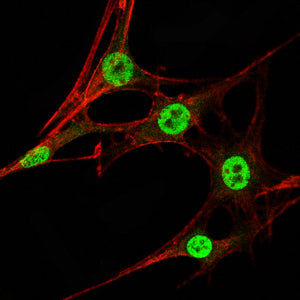
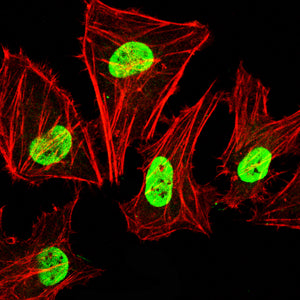
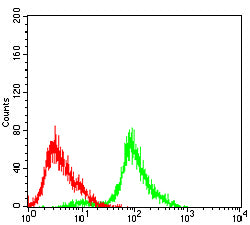
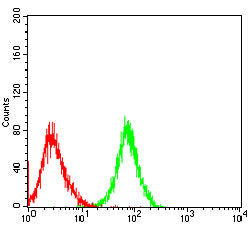
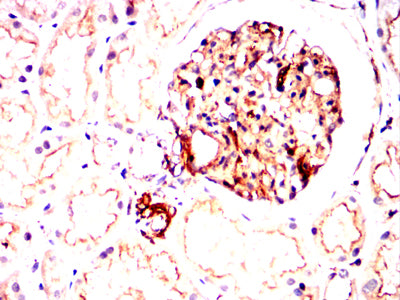
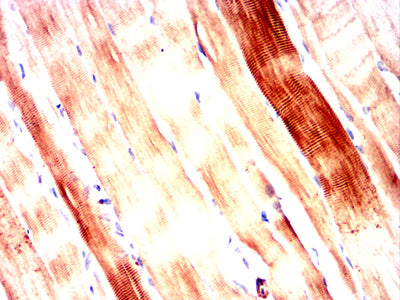
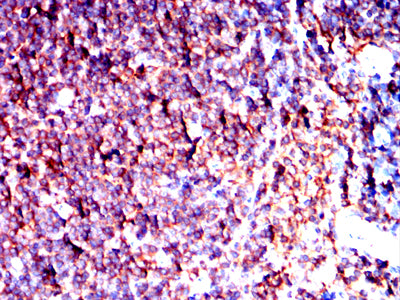
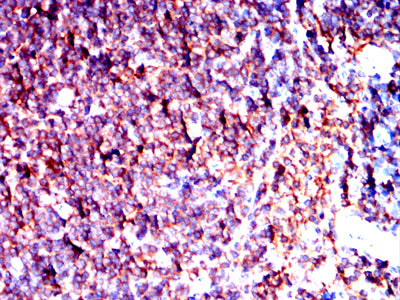
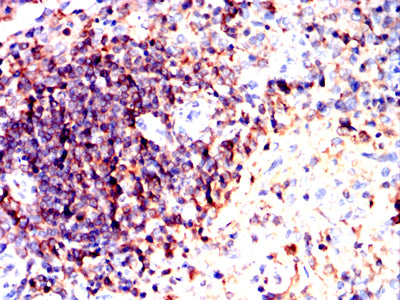
| WB | 咨询技术 | Human, Mouse, Monkey, Rat |
| IF | 咨询技术 | Human, Mouse, Monkey, Rat |
| IHC | 1/200 - 1/1000 | Human, Mouse, Monkey, Rat |
| ICC | 1/200 - 1/1000 | Human, Mouse, Monkey, Rat |
| FCM | 1/200 - 1/400 | Human, Mouse, Monkey, Rat |
| Elisa | 1/10000 | Human, Mouse, Monkey, Rat |
| Aliases | AT1; ATA; ATC; ATD; ATE; ATDC; TEL1; TELO1 |
| Entrez GeneID | 472 |
| clone | 3H12H8 |
| WB Predicted band size | 350.7kDa |
| Host/Isotype | Mouse IgG2b |
| Antibody Type | Primary antibody |
| Storage | Store at 4°C short term. Aliquot and store at -20°C long term. Avoid freeze/thaw cycles. |
| Species Reactivity | Human, Mouse, Monkey, Rat |
| Immunogen | Purified recombinant fragment of human ATM (AA: 2577-3056) expressed in E. Coli. |
| Formulation | Purified antibody in PBS with 0.05% sodium azide |
+ +
以下是关于ATM抗体的3篇参考文献,涵盖其应用机制及疾病研究:
---
1. **标题**: *ATM-dependent phosphorylation of the checkpoint kinase CHK2 in response to DNA damage*
**作者**: Ahn, J.Y., Schwarz, J.K., Piwnica-Worms, H., & Canman, C.E.
**摘要**: 该研究利用ATM抗体验证ATM蛋白在DNA损伤后对CHK2激酶的磷酸化调控作用,揭示了ATM通过激活下游信号通路参与细胞周期检查点调控的机制。
2. **标题**: *Defective kinase activity and DNA repair in ATM-deficient cells*
**作者**: Lavin, M.F., & Shiloh, Y.
**摘要**: 通过ATM抗体检测ATM缺失细胞系中的蛋白表达,发现ATM激酶活性缺陷导致DNA双链断裂修复异常,解释了共济失调毛细血管扩张症(AT)患者的基因组不稳定性。
3. **标题**: *Expression and functional analysis of ATM variants in cancer progression*
**作者**: Sun, Y., Jiang, X., & Chen, J.
**摘要**: 研究采用ATM抗体分析多种癌症组织中的ATM蛋白表达水平,发现ATM表达缺失与肿瘤对放化疗敏感性相关,为靶向ATM的癌症治疗提供依据。
---
以上文献可通过PubMed或Google Scholar检索原文。如需更近期研究,建议结合关键词“ATM antibody”及“2020-2023”筛选。
ATM antibodies target the Ataxia-Telangiectasia Mutated (ATM) protein, a critical serine/threonine kinase involved in DNA damage response (DDR). Discovered in studies of the autosomal recessive disorder Ataxia-Telangiectasia (A-T), ATM is activated by double-strand DNA breaks (DSBs) and coordinates cell cycle checkpoints, DNA repair, and apoptosis. Mutations in the ATM gene cause A-T, characterized by neurodegeneration, immune dysfunction, and heightened cancer risk.
ATM antibodies are widely used in research to detect ATM expression, phosphorylation status (e.g., active ATM phosphorylates substrates like CHK2 and p53), and subcellular localization via techniques like Western blotting or immunofluorescence. They also aid in diagnosing A-T by identifying reduced or dysfunctional ATM protein in patient cells. Beyond A-T, ATM dysregulation is implicated in cancers (e.g., leukemia, breast cancer) and radiation sensitivity studies, as ATM-deficient cells fail to repair radiation-induced DSBs. Recent therapeutic efforts focus on ATM inhibitors to sensitize cancer cells to radiotherapy or chemotherapy. However, ATM's dual role in tumor suppression and treatment resistance complicates its targeting. Research continues to unravel ATM's interactions with DDR pathways, its non-canonical roles in oxidative stress, and potential as a biomarker or therapeutic target.
×